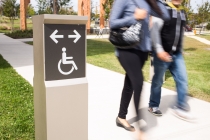At UMBC, stairs and uphill walks make getting to an early morning class seem like the end of Moses’ journey to the promised land. It is commonplace to see fellow classmates arrive while gasping for air on warm days in a rush to get to class.
However, in perspective, there are fellow students of our university with much more pressing matters when it comes to getting to their classes on time. Students with physical disabilities have difficulties navigating our hill-filled campus, but UMBC hasn’t made it a pressing concern to make it easier for them.
When asked whether or not it was easy for students with physical disabilities to navigate campus, UMBC’s Disability Specialist at Student Support Services, Valerie D. Valentine, made it very clear that the answer was no, but the campus is “very sensitive to the needs of its students.”
Valentine explained that SSS “make[s] accommodations for the classroom only,” but, “there is a route to all buildings without [use of] stairs.” However, it is still abundantly clear that the the stairs on campus are the fastest way from class to class.
Facilities on academic row are not as tedious to get to for physically disabled students, but buildings such as Information Technology/Engineering and the dreaded Performing Arts and Humanities Building take a much longer trip.
For instance, for the majority of us the PAHB is a tiring yet relatively short journey up the stairs. For students with physical disabilities, the prescribed route is to take the elevator up to the third floor of the University Center, go to the Engineering Building, then take the elevator up to the third floor of the Engineering Building and then the PAHB is a short distance from there.
Curious, I timed the journey to PAHB from lower academic row taking the stairs and it came to two minutes. With the accessibility route, it took the better part of about seven minutes. While this route would be the only option for those with physical disabilities, it is not necessarily the best option in efficiency. Physically disabled student Tess Moscato, a freshman computer engineering major, agreed that “access is available but [it is] not the most direct route,” and, “some of the handicapped doors are broken and it’s sometimes annoying.”
It is no secret that UMBC is sometimes a bit of a journey for everyone due to the incline of the campus, but for those of the student body without the ease of simply walking, it is much more complicated. UMBC in partnership with SSS obviously has measures and means of assistance in place for physically disabled students, but the issue seems to be that SSS deals mostly with classroom accommodations, and issues that aren’t classroom related end up unaddressed.
Not only are handicapped routes significantly more lengthy in time, but anyone can make use of the elevators. Perhaps if there was more handicap accessibility on campus that is not only less tedious, but also designed for those in need of it, it would benefit the student body. With stress of academics, extracurriculars and other common college anxieties, an efficient route to class is a need for everyone.

